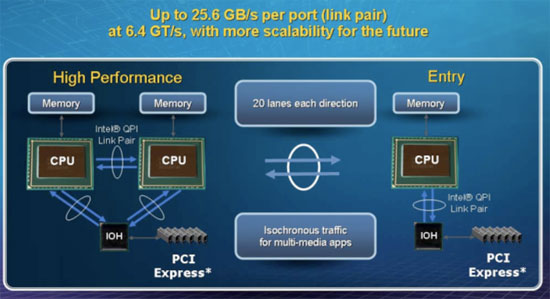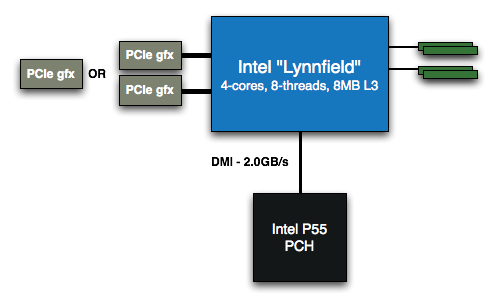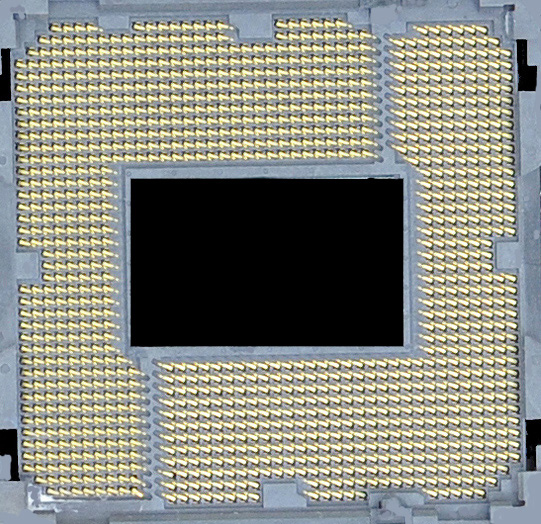The Lynnfield Preview: Rumblings of Revenge
by Anand Lal Shimpi on May 29, 2009 1:00 PM EST- Posted in
- CPUs
Making Nehalem Affordable: LGA-1156
Take the Core i7, shave off one memory controller and replace the high bandwidth QPI link with Intel’s slower DMI and you’ve got the makings of a (more) mainstream Nehalem.
Many have been calling this processor the Core i5 although I’m not quite ready to jump on that bandwagon, so I’ll keep referring to it by its socket (LGA-1156) or codename (Lynnfield).
Intel’s QPI is a very fast bus delivering up to 25.6GB/s of bandwidth. The image below shows you how Intel sees it being useful:

If you’ve got a multi-socket system (e.g. dual processor Xeon workstation, or Skulltrail successor) or if you’ve got a lot of high bandwidth PCIe devices (e.g. multi-GPU or lots of Larrabees) then QPI makes a whole lot of sense. However, if you’ve got a single socket system and aren’t running a lot of high bandwidth PCIe devices then QPI is overkill.
Intel’s DMI is the link used between the X58 chipset and the ICH10 I/O controller, it’s a much more conservative bus capable of delivering 2 - 4GB/s of bandwidth. That’s enough bandwidth for things like SATA and USB but a single PCIe x16 slot can deliver 16GB/s of bandwidth, far too much for Intel’s DMI.
Instead of crippling graphics on its mainstream platform, Intel did the next best thing and integrated 16 PCIe 2.0 lanes onto the die of its mainstream Nehalem part.
What you get looks like this:

A Lynnfield system only need two chips (CPU + PCH) while a Bloomfield system needs three (CPU + IOH + ICH)
The 16 PCIe 2.0 lanes can be configured as one x16 or two x8, allowing you enough bandwidth and very low latency to do things like CrossFire or SLI. Any additional PCIe lanes will branch off of what Intel is now calling the Platform Controller Hub (PCH). The first PCH is Intel’s P55 chipset; all you need is a Lynnfield CPU and the P55 PCH, no additional ICH is necessary as all of that functionality is embedded in the PCH.
The price of Intel’s P55 PCH is also much lower than the X58 chipset, in fact P55 is expected to be price competitive with P45 + ICH10. In other words, we should eventually see P55 boards priced at $100 or less.
Getting rid of QPI and one of the three DDR3 channels knocked down the pin-count of LGA-1366, but adding in 16 PCIe 2.0 lanes brought it back up to 1156 which you can count in the socket below:

I’ve blacked out the motherboard around it and the caps in the middle to protect the innocent.










95 Comments
View All Comments
TA152H - Friday, May 29, 2009 - link
OK, Ruckus, think about this instead of making your own crazy remarks.This is an identical processor in every way, except the memory controller, right? It's got the same functional units, same architecture, even the same cache system.
So the only time it matters, is when it's reading memory from outside itself.
So, the instruction has to be a read, and then has to miss the L1 cache, L2 cache, and L3 cache. This should be under 1% for most workloads, and certainly a very low number for almost all. So, it's not like we're reading memory outside of the processor that often, but it's still considerably slower. It's not 5% slower for reads, it's 5% slower for the entire application. So, it's very surprising to see this. If the cache architecture were different, I could see it, but it's really not. That's why I'm so surprised just the memory subsystem being brain-damaged has such a huge impact.
Take a look at different memory speeds, and despite dramatic differences in clock speeds, you don't really see these types of differences. So, it's alarming to me that using the same memory, you see some significant differences in performance. You'd be better off getting an i7 and getting slower memory in most cases, because you can always buy faster memory later, but you won't be able to fix the Lynnfield's incompetent memory controller.
Maybe it's as the other guy said, early silicon. I sure hope so. Otherwise, they've made a bad trade-off.
ssj4Gogeta - Friday, May 29, 2009 - link
Also, you're comparing an early engineering sample CPU on an early engineering sample mobo with a retail part.TA152H - Friday, May 29, 2009 - link
I'll agree there's a real possibility that this is one of the issues. Let's hope you're right. I really don't understand how it can be so slow compared to the i7, so, you probably have something here.ssj4Gogeta - Friday, May 29, 2009 - link
"This sounds like a brain-damaged chip that should not be made."Why don't you consider the price? You're getting performance almost equal to i7 920 for $200 less (price difference in mobo + CPU). Or you can get better performance than 920 for $100 less (CPU price same, but mobo is cheaper) from a 2.80 GHz Lynnfield. Of course you may like to buy high-end chips, but many people want budget systems. I don't think this chip should "not be made".
mmpalmeira - Friday, May 29, 2009 - link
The performance of a 2.8Ghz Lynnfield will probably match the 920's. Like it was said the 2.66 Ci5 is 5~7% slower them the 920. On the other hand MSI has just announced a U$165,00 I doubt that a Ci5 board will sell for less them U$100~110 at very best. Probably there won't be even a U$50,00 difference.TA152H - Friday, May 29, 2009 - link
I think you're saying the same thing I am, that the i7 is the way to go.The 2.8 GHz Lynnfield should underperform the i7. It's not going to make up more than it's clock speed ratio improvement, and there are some benchmarks where the i7 is 10% faster. Clearly, the Lynnfield will not scale well, since the memory performance is relatively poor compared to the i7. As you go to higher clock speeds, you should see them diverge more.
Also, turbo mode on the Lynnfield was boosting by 166 MHz, not the 133 MHz for the i7. This gave it an advantage it probably will not enjoy in real life. It makes no sense the i7 doesn't get the same boost from turbo mode, so I'd expect Intel to deal with that when they come out with new revisions. It's hard to imagine Intel giving the low end Lynnfield a big advantage over it's higher end brother. Since they're not selling Lynnfield now, leaving the low-end i7s turbo mode isn't problematic, and helps differentiate it from the higher end one. But, it's very doubtful it will be inferior to the crippled Lynnfield in this area.
TA152H - Friday, May 29, 2009 - link
Where are you getting this data from? Are you just making it up, because you have a feeling???The 2.8 GHz Lynnfield probably will underperform the 2.66 i7, while costing the same. It's about 5% faster, and processors do not scale linearly with clock speed, as you hopefully know. Plus, it's relatively easy to bump up the clock speed, there's a word for this "overclocking", which I hope you've heard of. Try changing the memory controller on the i5.
The price of the x58 seems artificially inflated. Compared to the x48, it should be significantly cheaper, since there's no memory controller on it. But, it's not.
I'd rather see Intel stop inflating the prices for the i7, rather than create a brain-damaged processor and make people buy it. The costs of making both platforms is probably not nearly what you're saying. Again, look at the x48. Why should the Nehalem motherboards be so much more expensive? It's not like they're so much more complicated.
We'll know more when we see the sizes of these chips. But, I really believe Intel is bumping up the prices a lot on these chipsets. I don't blame them entirely, because they can, and they have a responsibility to their stockholders. But, for us, it would be better to have reasonably priced i7s, than brain-damaged i5s.
ssj4Gogeta - Friday, May 29, 2009 - link
They're a business after all, and they sell CPU's to make money. Why do you expect them to price their products according to their manufacturing price instead of according to their performance?Of course i7 is a better alternative for enthusiasts, who know how to overclock. But there are MANY others who don't, and they'd rather save those $50 (or whatever difference it will be) because they can't justify it. I'm not saying i5 makes sense for people like us, but it certainly isn't a part which should not be made.
And better turbo mode on i5 DOES make sense - people who don't know how to overclock can benefit from that extra headroom. You're overclocking i7 to its limits anyways, so a bigger turbo doesn't really make much sense.
I'm going to buy an i7 anyways and wait for Gulftown. :D
aeternitas - Sunday, June 7, 2009 - link
It sounds like TA152H recently spent alot on an i7 system only to read all of this. I can understand that sort of frustration. Spending 200$+ on 5% and bandwidth one may never use in terms of whats in the PCI/e slots.However this isnt the place to grasp at straws.
JarredWalton - Friday, May 29, 2009 - link
I don't think Lynnfield is "brain damaged" any more than tri-core Phenom or dual-core Core 2 are "brain damaged". It's like saying Core i7 parts are stupid and shouldn't be made because they're not Xeons - or that Intel and AMD should stop making budget CPUs like the Pentium Dual-Core and Athlon X2 stuff. Tri-channel memory has very little impact on most desktop users, so removing that feature and going with dual-channel is perfectly reasonable.On the other hand, I do agree that having separate platforms for mainstream and high-end parts is not doing consumers any favors. Now you can lock yourself into either LGA-1366 or LGA-1156, and that means you might eventually hit a dead-end. Hopefully we don't see anything like AMD's old socket 940 "enthusiast" platform where users are abandoned after a few CPU updates. I'd prefer Intel to focus on 1366 and let economies of scale take care of the rest. But then they'd need to charge less for some high-end parts. :p